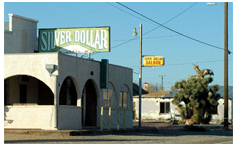Red Mountain is a mining district located at an elevation of roughly 3,600 feet in the Mojave Desert along what is now Highway 395, some 23 miles north of Kramer Junction. It was the location of a significant silver mine in a general geographic area that was notable for gold mines. It was originally named Osdick after one if the early miners that worked the area.
Not too far across the San Bernardino County line in Kern County, on April 25, 1895, three miners, Charles A. Burcham, F.M. Mooers and John Singleton discovered gold in the area at a place they designated as Rand Camp. Rand Camp would later become known as the Yellow Aster Mine and the town that grew about it was called Randsburg, the population of which by 1896 had swelled to 1,500. A post office was established there on April 16, 1896. In 1897 the first bank in the area was established in Randsburg. Shortly thereafter a grammar school was in operation. In 1898 the Randsburg Railroad from Kramer Junction was completed on January 5 and later that year the Yellow Aster Mine was augmented with a 30 stamp mill. A church was established and in January 1899 the population had reached 3,500. The Orpheum Theatre was built that year. According to a newspaper report, $3 million in gold was taken out of the Yellow Aster Mine in 1900. The following year a new grammar school was built along with a new 100 stamp mill. In 1903, there was a labor strike at the Yellow Aster Mine.
In 1904, the Santa Barbara Church was built in Randsburg after the previous place of worship burned. In 1905 tungsten was discovered in Atolia, which is roughly 5 miles south of Randsburg on Highway 395. in northwestern San Bernardino Counthy. The town got its name from two mining company officials, Atkins and DeGolia. As Atolio grew, it boasted being host to a dairy, a movie theater, and the Bucket of Blood saloon.
In 1911, the Yellow Aster Mine produce $6 million worth of gold. In 1913 Charles A. Burcham died and in May 1914 John Singleton died, leaving Dr. Rose Burcham as the sole owner of the Yellow Aster Mine.
In 1915 Dave Bowman found a gold nugget in Red Rock Cajon which sold for $1,979 and Al Wiser and Charles Koehn found a sizable nugget at their mine near Red Rock Cajon and Last Chance Canyon Road.
By 1916 there was a tungsten boom in Atolia when the price had increased to $90 per unit. Atolia’s population surged to 2,000.
With America’s 1917 entrance into WWI, which was then called The Great War, the population in the area dropped dramatically. This was exacerbated by a flu epidemic. The town of Randsburg and its outlying gold mining district was dying. But in 1918 silver was found in substantial quantities by some miners prospecting in San Bernardino County in what is now Red Mountain. A boom ensued there, with the Kelly Mine being the most prolific source. A stamp mill, the vestiges of which are yet extant, was built. In 1922, the town, then called Osdick, garnered a post office. The rich lode of silver in Red Mountain attracted miners who were willing to use their success in Red Mountain to stake them to prospecting forays for more valuable gold across the Kern County line.
In the late 1920s and early 1930s, vice activity in the dual forms of speakeasies and brothels proliferated in Red Mountain. In 1933, the Randsburg Railroad discontinued operation. Nevertheless, silver mining was hugely successful in Red Mountain and gold miners in Randsburg were doing very well.
IIn 1942, the War Production Board, in an effort to conserve equipment and manpower for essential war uses, issued an order requiring non-essential gold mines to cease operating. This resulted in the decline of Randsburg and then Red Mountain. Nevertheless, in the 1940s, Red Mountain remained famous – or infamous – for its bordellos.
In the 1980s, as the price of gold and silver increased, miners again sought to try their luck in the Randsburg and Red Mountain district. At the turn of the millennium, some miners were yet functioning in the area, making enough money to carry on. At this point, Red Mountain is ghost town, a relic of the past, though some 130 people live in and around it.
SBCSentinel
News of note from around the largest county in the lower 48 states.

